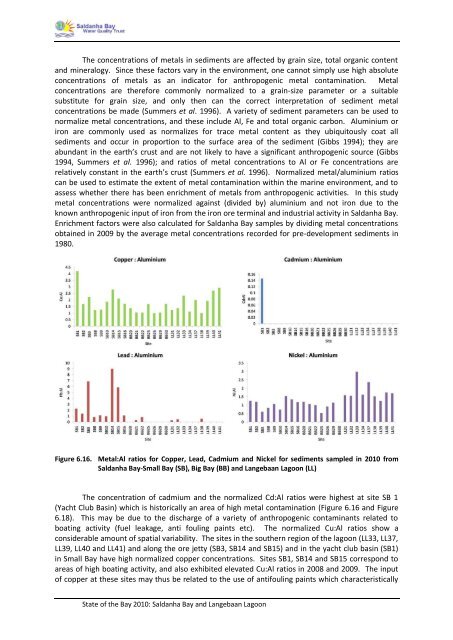State of the Bay Report 2010-Final - Anchor Environmental
State of the Bay Report 2010-Final - Anchor Environmental
State of the Bay Report 2010-Final - Anchor Environmental
Create successful ePaper yourself
Turn your PDF publications into a flip-book with our unique Google optimized e-Paper software.
The concentrations <strong>of</strong> metals in sediments are affected by grain size, total organic content<br />
and mineralogy. Since <strong>the</strong>se factors vary in <strong>the</strong> environment, one cannot simply use high absolute<br />
concentrations <strong>of</strong> metals as an indicator for anthropogenic metal contamination. Metal<br />
concentrations are <strong>the</strong>refore commonly normalized to a grain-size parameter or a suitable<br />
substitute for grain size, and only <strong>the</strong>n can <strong>the</strong> correct interpretation <strong>of</strong> sediment metal<br />
concentrations be made (Summers et al. 1996). A variety <strong>of</strong> sediment parameters can be used to<br />
normalize metal concentrations, and <strong>the</strong>se include Al, Fe and total organic carbon. Aluminium or<br />
iron are commonly used as normalizes for trace metal content as <strong>the</strong>y ubiquitously coat all<br />
sediments and occur in proportion to <strong>the</strong> surface area <strong>of</strong> <strong>the</strong> sediment (Gibbs 1994); <strong>the</strong>y are<br />
abundant in <strong>the</strong> earth’s crust and are not likely to have a significant anthropogenic source (Gibbs<br />
1994, Summers et al. 1996); and ratios <strong>of</strong> metal concentrations to Al or Fe concentrations are<br />
relatively constant in <strong>the</strong> earth’s crust (Summers et al. 1996). Normalized metal/aluminium ratios<br />
can be used to estimate <strong>the</strong> extent <strong>of</strong> metal contamination within <strong>the</strong> marine environment, and to<br />
assess whe<strong>the</strong>r <strong>the</strong>re has been enrichment <strong>of</strong> metals from anthropogenic activities. In this study<br />
metal concentrations were normalized against (divided by) aluminium and not iron due to <strong>the</strong><br />
known anthropogenic input <strong>of</strong> iron from <strong>the</strong> iron ore terminal and industrial activity in Saldanha <strong>Bay</strong>.<br />
Enrichment factors were also calculated for Saldanha <strong>Bay</strong> samples by dividing metal concentrations<br />
obtained in 2009 by <strong>the</strong> average metal concentrations recorded for pre-development sediments in<br />
1980.<br />
Figure 6.16. Metal:Al ratios for Copper, Lead, Cadmium and Nickel for sediments sampled in <strong>2010</strong> from<br />
Saldanha <strong>Bay</strong>-Small <strong>Bay</strong> (SB), Big <strong>Bay</strong> (BB) and Langebaan Lagoon (LL)<br />
The concentration <strong>of</strong> cadmium and <strong>the</strong> normalized Cd:Al ratios were highest at site SB 1<br />
(Yacht Club Basin) which is historically an area <strong>of</strong> high metal contamination (Figure 6.16 and Figure<br />
6.18). This may be due to <strong>the</strong> discharge <strong>of</strong> a variety <strong>of</strong> anthropogenic contaminants related to<br />
boating activity (fuel leakage, anti fouling paints etc). The normalized Cu:Al ratios show a<br />
considerable amount <strong>of</strong> spatial variability. The sites in <strong>the</strong> sou<strong>the</strong>rn region <strong>of</strong> <strong>the</strong> lagoon (LL33, LL37,<br />
LL39, LL40 and LL41) and along <strong>the</strong> ore jetty (SB3, SB14 and SB15) and in <strong>the</strong> yacht club basin (SB1)<br />
in Small <strong>Bay</strong> have high normalized copper concentrations. Sites SB1, SB14 and SB15 correspond to<br />
areas <strong>of</strong> high boating activity, and also exhibited elevated Cu:Al ratios in 2008 and 2009. The input<br />
<strong>of</strong> copper at <strong>the</strong>se sites may thus be related to <strong>the</strong> use <strong>of</strong> antifouling paints which characteristically<br />
<strong>State</strong> <strong>of</strong> <strong>the</strong> <strong>Bay</strong> <strong>2010</strong>: Saldanha <strong>Bay</strong> and Langebaan Lagoon

















